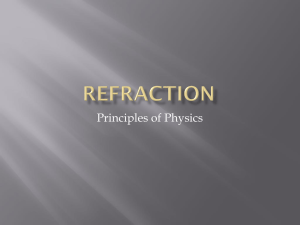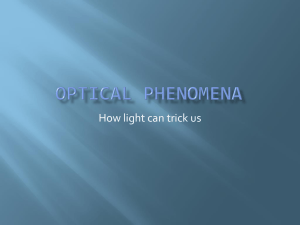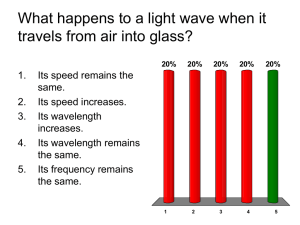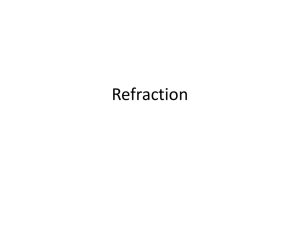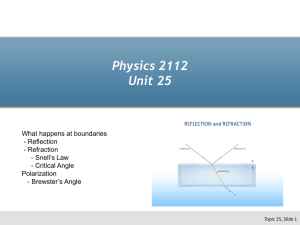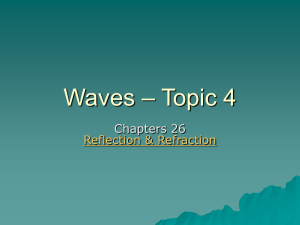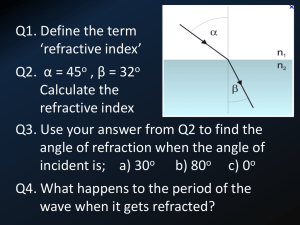Total internal reflection and critical angle
advertisement
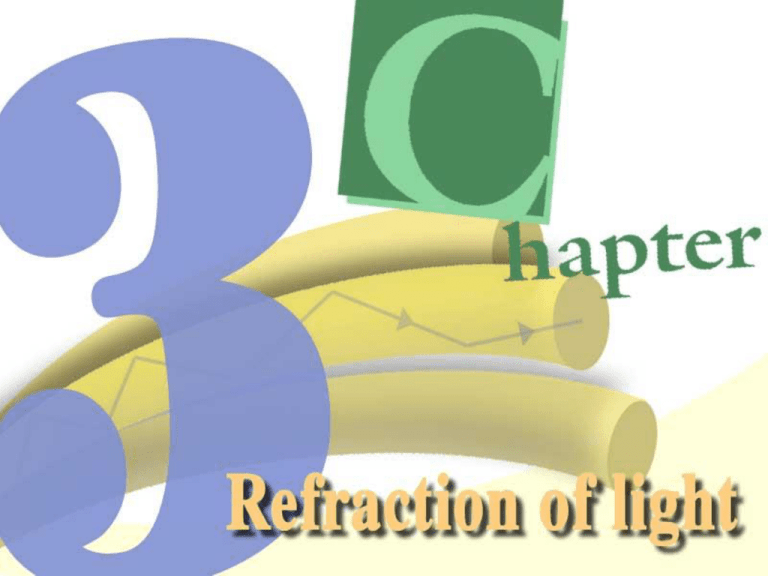
3 Refraction of light 3 Refraction of light 3 Refraction of light 3 Refraction of light 3.1 Refraction of light 3.2 Laws of refraction 3.3 Snell’s law and refractive index 3.4 Refraction through a block 3.5 Refraction through a prism 3.6 Real depth and apparent depth 3.7 Total internal reflection and critical angle 3 Refraction of light 3.8 Total internal reflection in prisms 3.9 Optical fibres 3.10 Formation of a mirage Summary 3.1 Refraction of light When light travels from one medium to another, it is bent or refracted. This is because light travels at different speeds in different media. Light travels faster in optically less dense media and slower in optically dense media. 3.1 Refraction of light The car hits the grass at an oblique angle. As the car changes speed, it changes direction. 3.1 Refraction of light The car hits the grass at right angles. There is no change of direction. 3.1 Refraction of light incident ray normal angle of incidence i air glass angle of refraction r refracted ray Describing refraction. 3.2 Laws of refraction 1 Rays of light travelling from air into glass are refracted towards the normal. 2 Rays of light travelling from glass into air are refracted away from the normal. We can conclude that light bends towards the normal in optically denser material. Experiment 3.1 Laws of refraction 3.2 Laws of refraction The laws of refraction state that 1 The incident ray, the refracted ray and the normal are in the same plane. 2 The ratio of the sine of the angle of incidence to the sine of the angle of refraction is a constant, this is called Snell's law. sin i sin r = constant 3.2 Laws of refraction A graph of sin i against sin r. 3.3 Snell’s law and refractive index This ratio of sin i to sin r for light rays passing from air to a medium is called the refractive index of that medium or nm. That is nm = sin i = sin r sin a sin m where a is the angle of incidence in air and m is the angle of refraction in the medium. 3.3 Snell’s law and refractive index Material Refractive index n Vacuum Air Water Perspex Glass Diamond 1.00 1.0003 (at 20ºC) 1.33 1.50 1.50 – 1.70 2.42 Refractive indexes of some materials. 3.4 Refraction through a block A incident ray D a b c d emergent ray B C lateral displacement Refraction by a rectangular glass block. 3.5 Refraction through a prism A angle of deviation emergent ray incident ray B C Deviation of light by a prism. 3.6 Real depth and apparent depth The apparent depth is less than the real depth because rays of light are refracted from the normal as they leave the water. The light rays appear to come from a point I which is a virtual image. Experiment 3.2 Apparent depth 3.6 Real depth and apparent depth apparent depth virtual image I The real and apparent depth of a swimmer. real depth 3.7 Total internal reflection and critical angle The inside of a glass block can act like a plane mirror. We can learn more about total internal reflection and the critical angle C in the following experiment. Experiment 3.3 Critical angle 3.7 Total internal reflection and critical angle very strong refracted ray semi-circular glass block ray box very weak reflected ray The angle of incidence is small. 3.7 Total internal reflection and critical angle strong refracted ray C strong reflected ray The angle of incidence is equal to the critical angle C. 3.7 Total internal reflection and critical angle very strong reflected ray The angle of incidence is larger than the critical angel. 3.8 Total internal reflection in prisms Prismatic periscope. Experiment 3.4 Construction of a prismatic periscope 3.8 Total internal reflection in prisms 45o 45o Two prisms being used in binoculars. Notice that the light rays are turned through 180 º after two internal reflections. 3.9 Optical fibres single glass fibre emergent light beam light beam bundle of fibres A bundle of glass fibres. Notice the total internal reflection in the fibre. 3.10 Formation of a mirage Sometimes, on a hot day, we see mirages. For example, a driver may see what looks like a large pool of water on the road. In fact, the road is dry. 3.10 Formation of a mirage cool air warm air total internal reflection here light from the sky looks like a pool of water hot air The road seems wet on a hot day. This is called a mirage. 3.10 Formation of a mirage A mirage is formed because there are hot layers of air near the hot road and a cooler and denser layer above it. Cool air has a greater refractive index than hot air. Summary • Total internal reflection and critical angle 9 Total internal reflection takes place when • light rays are travelling from an optically denser region to a less dense region, and • the angle of incidence is greater than the critical angle. 1 10 The refractive index = sin C or 1 C = sin-1 ( n )

